©Damen,
2021
Classical Drama
and Theatre
Return to Chapters
SECTION 2: CLASSICAL GREEK TRAGEDY AND THEATRE
Chapter 5: The Classical Age of Greece
I. Introduction: The Persian Wars and the Beginning of the Classical Age
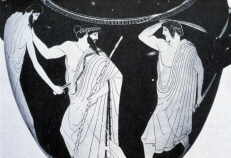 Pisistratus,
the tyrant of Athens during the last half-century of the Post-Classical period,
died shortly after he had instituted the City Dionysia. His sons inherited his
power but, not having their father's sense of creating coalitions, they were forcibly
removed from power soon after 512 BCE. It is not clear what happened next, but
it must be in these years of unrest and disorder (510-508 BCE) that democracy
first emerged in Athens.
Pisistratus,
the tyrant of Athens during the last half-century of the Post-Classical period,
died shortly after he had instituted the City Dionysia. His sons inherited his
power but, not having their father's sense of creating coalitions, they were forcibly
removed from power soon after 512 BCE. It is not clear what happened next, but
it must be in these years of unrest and disorder (510-508 BCE) that democracy
first emerged in Athens.
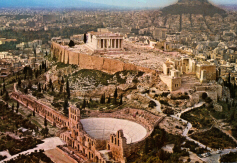 For
all the changes that may seem to entail, much remained the same. The rituals
and festivals, quite a few of which the tyrant Pisistratus had introduced and
promoted, continued on through the chaos of massive governmental reform, the
City Dionysia being no exception. By the early days of the fifth century (the
490's BCE), the Athenians had settled into their new type of government where
the general populace exerted direct control of the city through assemblies and
the enactment of laws, and governmental measures regularly came to reflect the
will of the majority.
For
all the changes that may seem to entail, much remained the same. The rituals
and festivals, quite a few of which the tyrant Pisistratus had introduced and
promoted, continued on through the chaos of massive governmental reform, the
City Dionysia being no exception. By the early days of the fifth century (the
490's BCE), the Athenians had settled into their new type of government where
the general populace exerted direct control of the city through assemblies and
the enactment of laws, and governmental measures regularly came to reflect the
will of the majority.
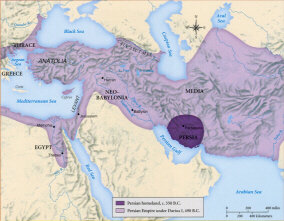 But
this new democratic regime hardly had a chance to catch its breath before it
faced the greatest crisis Greece was to confront in the early Classical
Age (the fifth century BCE). The massive and powerful Persian Empire
attacked Greece, not once but twice. These two so-called Persian Wars
(490 BCE; 481-479 BCE) are the primary focus of Herodotus' Histories
and make some of the most fascinating reading of all time. It is not possible
to do the Persian Wars justice here, only to note that, grossly out-numbered
and vastly out-armed, the Greeks managed in both wars to push the Persians out
of Greece mainly by setting aside traditional internal differences and fighting
together for their common independence. It was, no doubt, the finest hour in
ancient Greece and just about the only time the Greeks made common cause in
antiquity. [Click here
for more information about Herodotus and the Persian Wars.]
But
this new democratic regime hardly had a chance to catch its breath before it
faced the greatest crisis Greece was to confront in the early Classical
Age (the fifth century BCE). The massive and powerful Persian Empire
attacked Greece, not once but twice. These two so-called Persian Wars
(490 BCE; 481-479 BCE) are the primary focus of Herodotus' Histories
and make some of the most fascinating reading of all time. It is not possible
to do the Persian Wars justice here, only to note that, grossly out-numbered
and vastly out-armed, the Greeks managed in both wars to push the Persians out
of Greece mainly by setting aside traditional internal differences and fighting
together for their common independence. It was, no doubt, the finest hour in
ancient Greece and just about the only time the Greeks made common cause in
antiquity. [Click here
for more information about Herodotus and the Persian Wars.]
II. The Classical Age
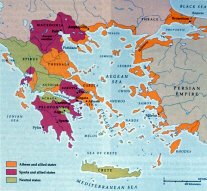 Athens
emerged from the Persian Wars triumphant. Using their navy and merchant marine,
the Athenians took control of the seas around Greece. With renewed prosperity
and a keen sense of their own importance in international affairs, they set
about repairing the damage incurred during the wars and extending the traditions
established prior to the Persian invasion, in particular, drama, painting and
architecture.
Athens
emerged from the Persian Wars triumphant. Using their navy and merchant marine,
the Athenians took control of the seas around Greece. With renewed prosperity
and a keen sense of their own importance in international affairs, they set
about repairing the damage incurred during the wars and extending the traditions
established prior to the Persian invasion, in particular, drama, painting and
architecture.
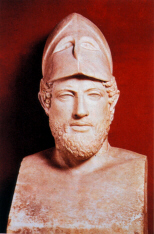 Part
of the reason for this surge in the arts was the confidence born of victory
and independence. In antiquity, to win a war was to gain the assurance that
one's gods were pleased, which meant that the ceremonies and celebrations performed
in their honor must be to their liking. From that vantage point, it only makes
sense to continue and even extend them.
Part
of the reason for this surge in the arts was the confidence born of victory
and independence. In antiquity, to win a war was to gain the assurance that
one's gods were pleased, which meant that the ceremonies and celebrations performed
in their honor must be to their liking. From that vantage point, it only makes
sense to continue and even extend them.
Thus, the Classical Age was scion and heir of a sense
of righteous vigor. Led by Pericles, a man who had to be re-elected
to office every year but who was nonetheless firmly in control of Athens for
much of his life, the Athenians set about expanding their commercial interests.
Wealth soon poured into the city from an alliance called the Delian League which
they had formed after the war for the benefit of all Greece, but their own mostly.
 This
new prosperity fostered many different cultural endeavors. The Parthenon,
for instance, rose on the site of an old wooden temple to Athena on the Acropolis,
the natural outcropping of rock in the middle of the city. During the Second
Persian War, the Persian king Xerxes had burnt the old temple to the ground,
a destruction that, devastating as it was, opened the way for a new, more modern
and more elaborate shrine to the patron goddess of Athens. (Click here
for more information about the Parthenon and other sacred spaces in antiquity.)
This
new prosperity fostered many different cultural endeavors. The Parthenon,
for instance, rose on the site of an old wooden temple to Athena on the Acropolis,
the natural outcropping of rock in the middle of the city. During the Second
Persian War, the Persian king Xerxes had burnt the old temple to the ground,
a destruction that, devastating as it was, opened the way for a new, more modern
and more elaborate shrine to the patron goddess of Athens. (Click here
for more information about the Parthenon and other sacred spaces in antiquity.)
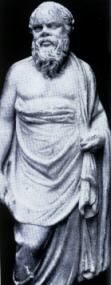 On
the intellectual front, the best thinkers in the Greek-speaking world also flocked
to Athens and imported a new way of looking at life dubbed philosophy
("love of wisdom"). At first these so-called sophists—the
term originally meant "craftsmen"—became teachers and popular
lecturers and then began to uproot the traditional modes of thought and later
morality in Athens. Sophist as a moniker eventually came to be a slur implying
"quack" and "charlatan," but there was no denying, at least
at the outset, that these "artisans" taught valuable skills which
won many a lawsuit and much political advancement for their students.
On
the intellectual front, the best thinkers in the Greek-speaking world also flocked
to Athens and imported a new way of looking at life dubbed philosophy
("love of wisdom"). At first these so-called sophists—the
term originally meant "craftsmen"—became teachers and popular
lecturers and then began to uproot the traditional modes of thought and later
morality in Athens. Sophist as a moniker eventually came to be a slur implying
"quack" and "charlatan," but there was no denying, at least
at the outset, that these "artisans" taught valuable skills which
won many a lawsuit and much political advancement for their students.
Underlying most of the sophists' tenets was a sense of relativism,
that there is no fundamental good or bad, a dangerously cynical posture that
bordered on atheism and threatened to erode the moral structures on which civil
order, especially in a democratic society, depends. One sophist, the most famous,
Protagoras, went so far as to say, "Man is the measure
of all things." This maxim became the byword of the increasingly humanistic
Classical Age.
The challenge presented by these sophists was met by perhaps the greatest team
of thinkers in human history, Socrates and Plato.
This teacher-and-student duo led the charge to set morality back on a firm foundation
of strict philosophical argumentation and to counter the relativism of the sophistic
movement. All cynics and sceptics since have had to face up to the dialogues
of Socrates in which, as recorded by his student Plato, the master attacks various
free-thinkers and debunks their wide-ranging claims that moral absolutes do
not exist. It is still not clear which side won, but with this pair, staunch
moralists gained a valuable and much-needed ally in the long on-going war between
idealism and practicality, conviction and compromise, what ought to be versus
what has to be.
III. The Peloponnesian War and the Post-Classical Age
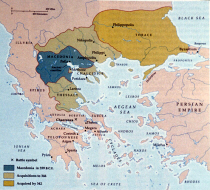 The
glory of Athens grew top-heavy by the later decades of the fifth century BCE.
Made greedy over time by the wealth they had come to expect, the Athenians started
expanding their realm by force. In response, Sparta initiated
a war with Athens in 431 BCE in an effort to curb the Athenians' imperialistic
designs, a quest for world domination as the Spartans saw it.
The
glory of Athens grew top-heavy by the later decades of the fifth century BCE.
Made greedy over time by the wealth they had come to expect, the Athenians started
expanding their realm by force. In response, Sparta initiated
a war with Athens in 431 BCE in an effort to curb the Athenians' imperialistic
designs, a quest for world domination as the Spartans saw it.
This on-and-off conflict is now known as the Peloponnesian War—Sparta
is in the Peloponnese (southern Greece) and we today see the war from the Athenians'
perspective since their records preserve the history of this conflict—it
was essentially a civil war among Greek city-states, ending with Sparta's defeat
of Athens in 404 BCE. The ultimate result was even worse. Weakened by incessant
in-fighting, all southern Greece fell to a foreign power in the next century.
The lesson to be learned about the consequences of a nation's failure to achieve
compromise and peaceably resolve its internal disagreements is as yet not fully
understood by many world leaders today: "United we stand . . ."
 In
this so-called Post-Classical Age (the fourth century, i.e.
the 300's BCE), the Greeks squabbled among themselves, allowing the expansion
of the kingdom to the north of them, Macedon(ia), an area populated
by Greek-speakers but ironically considered a "barbarian"
nation by their more cultured southern kin. In Greek, barbaros means "foreign," purportedly from the nonsense syllables "bar bar"
which is the way non-Greek languages sounded to the Greeks. During the first
half of the fourth century, the Macedonians gradually consolidated their power
in northern Greece and under the leadership of Philip II, a
crafty and ruthless ruler and a general of great skill, began to extend their
influence south.
In
this so-called Post-Classical Age (the fourth century, i.e.
the 300's BCE), the Greeks squabbled among themselves, allowing the expansion
of the kingdom to the north of them, Macedon(ia), an area populated
by Greek-speakers but ironically considered a "barbarian"
nation by their more cultured southern kin. In Greek, barbaros means "foreign," purportedly from the nonsense syllables "bar bar"
which is the way non-Greek languages sounded to the Greeks. During the first
half of the fourth century, the Macedonians gradually consolidated their power
in northern Greece and under the leadership of Philip II, a
crafty and ruthless ruler and a general of great skill, began to extend their
influence south.
 In
338 BCE, Philip succeeded in defeating the combined forces of the southern Greeks—Athens,
Thebes, and Sparta all fighting together for the first time since the Persian
Wars well over a century before!—and reduced them to a tribute-paying
protectorate of his burgeoning empire. He would surely have become one of the
best-known figures in history, had he not sired a son whose name and glory
resound through all time, Alexander the Great. Still barely
out of his teens, Alexander not only succeeded Philip as ruler of Greece but
over the course of the next decade (333-323 BCE) went on to conquer many lands,
including Asia Minor (modern Turkey), Egypt, and Persia, and even made incursions
into India. When he died suddenly of a mysterious ailment in 323 BCE, he left
behind a very different world.
In
338 BCE, Philip succeeded in defeating the combined forces of the southern Greeks—Athens,
Thebes, and Sparta all fighting together for the first time since the Persian
Wars well over a century before!—and reduced them to a tribute-paying
protectorate of his burgeoning empire. He would surely have become one of the
best-known figures in history, had he not sired a son whose name and glory
resound through all time, Alexander the Great. Still barely
out of his teens, Alexander not only succeeded Philip as ruler of Greece but
over the course of the next decade (333-323 BCE) went on to conquer many lands,
including Asia Minor (modern Turkey), Egypt, and Persia, and even made incursions
into India. When he died suddenly of a mysterious ailment in 323 BCE, he left
behind a very different world.
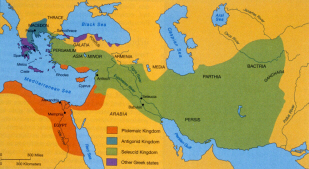 The
period after Alexander's lifetime is called the Hellenistic Age. Alexander
had died without siring a legitimate heir, giving his generals carte blanche
to seize and divide up his vast realm. These so-called diadochoi ("successors")
inaugurated three centuries of internecine conflict in the eastern Mediterranean
area. Governed by Ptolemy, one of Alexander's generals, followed by a long line of his
descendants, Egypt was the only of these "successor states" to thrive
and enjoy any stability, and indeed a Hellenized ("Greek-ified") Egypt
did prosper, becoming a home-away-from-home for many post-classical Greek authors.
The discovery there of thousands of papyri (scraps of "paper")
with Greek writing on them, dating to the third century BCE onward, is evidence
of the large number of Greek speakers who moved into Egypt in the Hellenistic
Age. Thus, the Greeks' business interests continued to expand even after the
Macedonian conquest, many becoming very wealthy in the course of their cosmopolitan
commercial adventures.
The
period after Alexander's lifetime is called the Hellenistic Age. Alexander
had died without siring a legitimate heir, giving his generals carte blanche
to seize and divide up his vast realm. These so-called diadochoi ("successors")
inaugurated three centuries of internecine conflict in the eastern Mediterranean
area. Governed by Ptolemy, one of Alexander's generals, followed by a long line of his
descendants, Egypt was the only of these "successor states" to thrive
and enjoy any stability, and indeed a Hellenized ("Greek-ified") Egypt
did prosper, becoming a home-away-from-home for many post-classical Greek authors.
The discovery there of thousands of papyri (scraps of "paper")
with Greek writing on them, dating to the third century BCE onward, is evidence
of the large number of Greek speakers who moved into Egypt in the Hellenistic
Age. Thus, the Greeks' business interests continued to expand even after the
Macedonian conquest, many becoming very wealthy in the course of their cosmopolitan
commercial adventures.
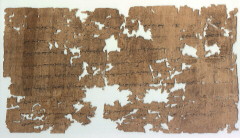 But,
if well-fed and secure, they were also lost and unhappy amidst their materialistic
bliss. One of the consequences of Alexander's dominion was to show what a small
and insignificant place Greece actually was in the larger—the much
larger!—world. Ironically, then, as the Greeks' monetary worth rose, their
sense of self-importance declined. It grew ever harder, for instance, to believe
that the Greek gods who presumably controlled the whole planet—and such
an expansive domain it had proven to be!—would choose to live on a cold,
medium-sized mountain in northern Greece, especially when it was now widely
recognized that they could reside in an excellent vacation spot like Egypt.
The Olympian religion, which had already suffered severe setbacks during the
intellectual turmoil of the Classical Age, started to falter seriously.
But,
if well-fed and secure, they were also lost and unhappy amidst their materialistic
bliss. One of the consequences of Alexander's dominion was to show what a small
and insignificant place Greece actually was in the larger—the much
larger!—world. Ironically, then, as the Greeks' monetary worth rose, their
sense of self-importance declined. It grew ever harder, for instance, to believe
that the Greek gods who presumably controlled the whole planet—and such
an expansive domain it had proven to be!—would choose to live on a cold,
medium-sized mountain in northern Greece, especially when it was now widely
recognized that they could reside in an excellent vacation spot like Egypt.
The Olympian religion, which had already suffered severe setbacks during the
intellectual turmoil of the Classical Age, started to falter seriously.
 While
not wholly discarding their ancestors' religion, many Hellenistic Greeks joined
foreign cults in a search for greater meaning and direction in life. Some put
religious structures aside altogether and indulged in philosophies,
essentially cults based on logical argumentation, but in reality they were still belief systems
of a sort. Spawned in the wake of Socrates and Plato, these philosophies dictated
ways of living that could be deduced through proper reasoning.
While
not wholly discarding their ancestors' religion, many Hellenistic Greeks joined
foreign cults in a search for greater meaning and direction in life. Some put
religious structures aside altogether and indulged in philosophies,
essentially cults based on logical argumentation, but in reality they were still belief systems
of a sort. Spawned in the wake of Socrates and Plato, these philosophies dictated
ways of living that could be deduced through proper reasoning.
The most important of these in the long run was Stoicism,
a philosophy centering around the premise that the universe is essentially good
and, therefore, suffering exists for the very purpose of building a better tomorrow.
The logical response to this situation, the Stoics preached, is
to distance oneself from any feelings of pain or remorse, to push aside emotion
and understand that things will turn out for the better even if they do not
seem that way at the moment. Thus, people should focus on their duty and ignore
the pain encountered in the passage through life as much as possible. Stoicism
has influenced a wide range of people then and now, from Saint Paul's conception
of Christianity to Gene Roddenberry's depiction of Vulcans in Star Trek.
Eventually, the internal conflicts of these Hellenistic kingdoms spelled their
doom. Yet another conqueror came along and took them down one by one. Unlike
the Greeks, this new regime had for a long time avoided the fatal pitfall of
internal bickering and thereby created the most powerful and long-lasting empire
yet in Western Civilization. These conquerors were, of course, the Romans
who began incorporating the Hellenistic Greek world into their realm around
200 BCE. Henceforth, Roman and Greek civilization would merge to form "Greco-Roman"
culture, the hybrid we know as classical antiquity. [Click here
for more information about the Hellenistic Literature and the Post-Classical
Age.]
IV. Conclusion
The history of Greece is a tale of glory and folly, of inordinate success
and incalculable waste. Perhaps because our strengths as humans almost invariably
come from the same sources as our weaknesses—to wit, the blindness that
leads many to be taken in by others also makes them brave in the face of overwhelming
danger—the same things that had fostered the civilization of the ancient
Greeks precipitated its fall, their unwavering belief in themselves and the
conviction that their ways were the right ways, the best ways, and finally the
only ways. In particular, the greed that drove the Peloponnesian War
and fomented all its disasters for Athens and Greece alike was part and parcel
of the Athenians' determination to improve themselves and their way of life.
That is, the fire that sparked the Classical Age also incinerated it.
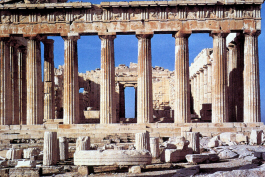 Likewise,
the Greeks' visionary art with all its grandeur and glory is tightly bound up
with the egotism that led them early on to trust their own divine instincts
but then also to underestimate the power of "barbarians" and eventually
fall to beings they looked down upon as inferior. The Parthenon is a perfect
example of how this all worked. It is a temple designed to please the human
eye, not some god looking down from above. It is a three-dimensional reflection
of the humanism that pervaded classical Greek thought, the
soul sister of Greek philosophy that saw truth as what appealed to the mind,
meaning the human mind. Raised out of the very bedrock of Greece, this
magnificent edifice proclaims the greatness of our species and at the same time
its ruins today show just how great we really are.
Likewise,
the Greeks' visionary art with all its grandeur and glory is tightly bound up
with the egotism that led them early on to trust their own divine instincts
but then also to underestimate the power of "barbarians" and eventually
fall to beings they looked down upon as inferior. The Parthenon is a perfect
example of how this all worked. It is a temple designed to please the human
eye, not some god looking down from above. It is a three-dimensional reflection
of the humanism that pervaded classical Greek thought, the
soul sister of Greek philosophy that saw truth as what appealed to the mind,
meaning the human mind. Raised out of the very bedrock of Greece, this
magnificent edifice proclaims the greatness of our species and at the same time
its ruins today show just how great we really are.
From the thin soil of their homeland, the pre-classical Greeks had built their civilization, a culture outstripping all previous ones
in Europe, and then threw it all
away fighting amongst themselves over those same dusty stones. In the end, the Greeks'
sense of self-worth was both their triumph and their downfall. As that is the theme of so many classical tragedies, it makes sense that drama became one of their most enduring achievements.
Terms, Places, People and Things to Know
|
Pisistratus
Athens
Classical Age
Persian Wars
Pericles [PAIR-uh-kleez]
Parthenon [PAR-thun-nawn]
Acropolis [uh-CROP-oh-liss]
Philosophy
Sophists
Protagoras [pro-TAG-or-us]
Socrates
Plato
|
Sparta
Peloponnesian War
Post-Classical Age
Macedon(ia) [MASS-suh-dawn; MASS-suh-DOH-nee-uh]
Barbarian
Philip II
Alexander the Great
Hellenistic Age
Papyri [pup-PIE-rye]
Stoicism [STOW-uh-sizz-um]
Romans
Humanism |
This work is licensed under a Creative Commons Attribution-NonCommercial-ShareAlike 4.0 International License.
 Pisistratus,
the tyrant of Athens during the last half-century of the Post-Classical period,
died shortly after he had instituted the City Dionysia. His sons inherited his
power but, not having their father's sense of creating coalitions, they were forcibly
removed from power soon after 512 BCE. It is not clear what happened next, but
it must be in these years of unrest and disorder (510-508 BCE) that democracy
first emerged in Athens.
Pisistratus,
the tyrant of Athens during the last half-century of the Post-Classical period,
died shortly after he had instituted the City Dionysia. His sons inherited his
power but, not having their father's sense of creating coalitions, they were forcibly
removed from power soon after 512 BCE. It is not clear what happened next, but
it must be in these years of unrest and disorder (510-508 BCE) that democracy
first emerged in Athens. 











